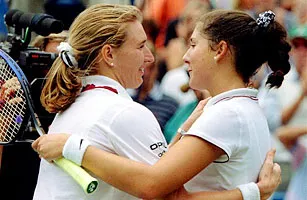Steffi Graf and Monica Seles shared one of the most intense rivalries in tennis during the early 1990s. Graf had dominated the late 1980s, but Seles quickly emerged as a serious challenger. With their contrasting playing styles—Graf’s powerful forehand and athleticism versus Seles’ aggressive two-handed shots—they produced some thrilling matches.
Their rivalry peaked at the 1992 French Open final, where Seles defeated Graf in three sets, securing her place as the world’s number one. Seles’ rise to the top threatened Graf’s reign, fueling fierce competition between the two. Both players had strong personalities, but their rivalry was mostly played out on the court, with no public signs of animosity.
However, the rivalry took a tragic turn in 1993 when Monica Seles was stabbed by Günter Parche, a Steffi Graf fan, during a match in Hamburg. Parche admitted he wanted to see Graf reclaim the top spot from Seles. The attack left Seles unable to compete for two years, changing the course of her career. Graf went on to dominate the women’s game during Seles’ absence.
Despite the tragedy, some speculated that Persina, Seles’ father, may have contributed to fueling the rivalry behind the scenes. However, these rumors were unsubstantiated and were mostly dismissed as unfounded. There was no credible evidence linking Persina to any tensions between the two players.
While the attack permanently altered their rivalry, Graf and Seles’ battles on the court are still remembered as some of the most competitive in tennis history. Their rivalry marked a defining era in women’s tennis, blending fierce competition with personal resilience.



